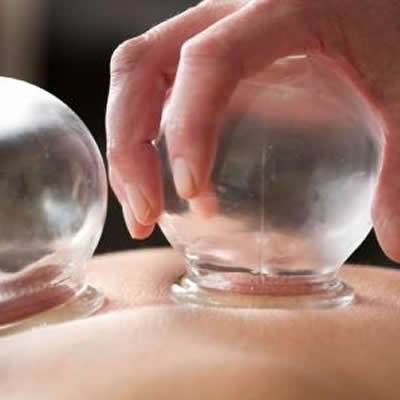Traditional Chinese Medicine
Originally posted March 21, 2012
Cupping
 Cupping is one of the oldest methods of traditional Chinese medicine. The earliest recorded use of cupping dates to the early fourth century. Originally, practitioners would use hollowed-out animal horns for cups, and place them over particular points or meridians. Today, most acupuncturists use cups made of thick glass or plastic, although bamboo, iron and pottery cups are still used in other countries. Glass cups are the preferred method of delivery, because they do not break as easily as pottery or deteriorate like bamboo, and they allow the acupuncturist to see the skin and evaluate the effects of treatment. In a typical cupping session, glass cups are warmed. Burning a substance inside the cup removes all the oxygen, which creates a vacuum. In China, cupping is used primarily to treat respiratory conditions such as bronchitis, asthma, and congestion; arthritis; gastrointestinal disorders; and certain types of pain. Some practitioners also use cupping to treat depression and reduce swelling. Fleshy sites on the body, such as the back and stomach (and, to a lesser extent, the arms and legs), are the preferred sites for treatment. In addition to the traditional form of cupping described above, which is known as “dry” cupping, some practitioners also use what is called “wet” or “air” cupping.In “air” cupping, instead of using a flame to heat the cup, the cup is applied to the skin, and a suction pump is attached to the rounded end of the jar. The pump is then used to create the vacuum. In “wet” cupping, the skin is punctured before treatment. When the cup is applied and the skin is drawn up, a small amount of blood may flow from the puncture site, which are believed to help remove harmful substances and toxins from the body.
Cupping is one of the oldest methods of traditional Chinese medicine. The earliest recorded use of cupping dates to the early fourth century. Originally, practitioners would use hollowed-out animal horns for cups, and place them over particular points or meridians. Today, most acupuncturists use cups made of thick glass or plastic, although bamboo, iron and pottery cups are still used in other countries. Glass cups are the preferred method of delivery, because they do not break as easily as pottery or deteriorate like bamboo, and they allow the acupuncturist to see the skin and evaluate the effects of treatment. In a typical cupping session, glass cups are warmed. Burning a substance inside the cup removes all the oxygen, which creates a vacuum. In China, cupping is used primarily to treat respiratory conditions such as bronchitis, asthma, and congestion; arthritis; gastrointestinal disorders; and certain types of pain. Some practitioners also use cupping to treat depression and reduce swelling. Fleshy sites on the body, such as the back and stomach (and, to a lesser extent, the arms and legs), are the preferred sites for treatment. In addition to the traditional form of cupping described above, which is known as “dry” cupping, some practitioners also use what is called “wet” or “air” cupping.In “air” cupping, instead of using a flame to heat the cup, the cup is applied to the skin, and a suction pump is attached to the rounded end of the jar. The pump is then used to create the vacuum. In “wet” cupping, the skin is punctured before treatment. When the cup is applied and the skin is drawn up, a small amount of blood may flow from the puncture site, which are believed to help remove harmful substances and toxins from the body.
Moxibustion
Moxibustion, or also known as Moxa is a form of fire heat treatment that stimulates specific acupuncture points of the body. A small, cone-shaped amount of moxa is placed on top of an acupuncture point and burned on the skin. Direct moxibustion is a traditional technique considered to be very therapeutic. Moxa along with acupuncture can be very effective for many diseases and conditions including back pain, muscle stiffness, headaches, migraines, tendonitis, arthritis, digestive disorders, anxiety, and female health problems such as menstrual cramps, irregular periods, and infertility. Moxa is generally not recommended for patients with diabetes, decreased sensitivity to pain, who are on certain medications or who have any other conditions involving compromised circulation or a weakened immune system.
Gua Sha
Gua Sha is a healing technique used by practitioners of Traditional Medicine. Gua Sha is a medicine technique used to remove blood stagnation that blocks the surface tissues impeding organ and immune function. It involves palpation stimulation where the skin is pressured by using strokes with a round edged instrument which then results in the appearance of red patches called ‘sha’, that will fade in 2 to 3 days.Raising Sha removes blood stagnation.Gua Sha treatments are not painful. As the body is scraped it pushes a build-up of fluid ahead of it, and after it passes, it leaves an indention or vacuum behind which draws toxic fluid out to the surface of the skin from deep within the tissue.Gua Sha creates suction on the skin that pulls stagnant intercellular fluid to the surface, removing toxic debris, and replacing it with fresh oxygenated, nutrient rich fluid, which in turn accelerates regeneration and revitalizes the region where cancer cells may or already have manifested.
DON'T MISS OUT Get the latest news from the Alaska Institute
Workshops ⋅ Classes ⋅ Tai Chi ⋅ Qigong ⋅ Kung Fu ⋅ Blog Posts ⋅ and so much more!
